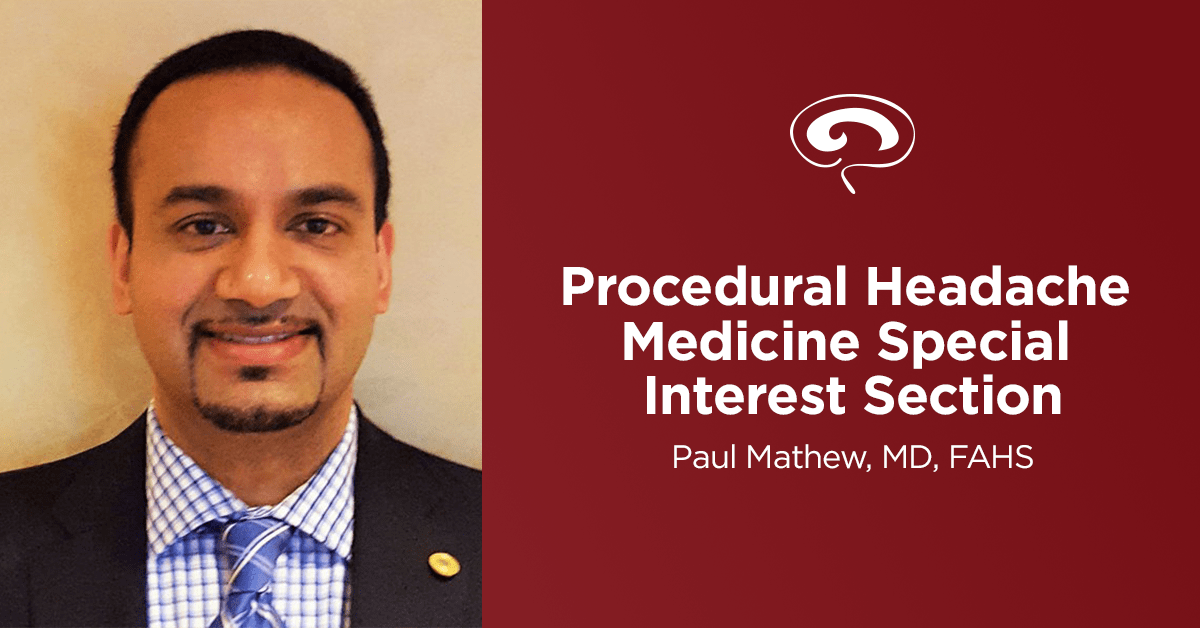
Special Interest Section Profile: Procedural Headache Medicine
Name of Section Chair
Paul Mathew, MD, DNBPAS, FAAN, FAHS
Name of Special Interest Section
Procedural Headache Medicine
Number of Members
150+
The American Headache Society is home to a diverse array of Special Interest Sections that connect members with shared expertise and interests to collaborate on research, develop practice models and provide multidisciplinary participation in support of the Society’s overall mission.
The goals of the Procedural Headache Medicine Special Interest Section closely align with the Society’s mission to improve treatment options for all patients with headache disorders. With an emphasis placed on peripheral nerve blocks and other interventional procedures for headache management, the Procedural Headache Medicine Section works to standardize and improve the field’s best practices for interventional headache management methods while simultaneously pursuing new information to advance our understanding of this suite of treatment options.

What is the mission of the special interest section?
Our Special Interest Section primarily focuses on the procedures that we commonly perform in headache medicine, including nerve blocks, trigger point injections, and botulinum toxin injections. Our goal is to build on existing evidence for each procedure, as well as outline what protocols are best-suited for a particular indication. Additionally, we are trying to advocate for adequate insurance coverage for patients that need these procedures.
What recent projects has your group been a part of?
Under the past chair, Jessica Ailani, MD, FAHS, there was a consensus paper written on the best practices for nerve blocks and trigger point injections, which have become the standard practice in the treatment of headache disorders. In the future, we hope to write additional guidelines and better standardize the procedures we currently perform.
What future goals does your special interest section have?
We want to solidify which diagnosis codes are going to be used to get certain procedures covered by insurance providers. One example is occipital neuralgia. A requisite for diagnosing occipital neuralgia is a response to occipital nerve blocks. It is both a diagnostic and therapeutic procedure; however, insurance providers are denying coverage for occipital nerve blocks for the treatment of occipital neuralgia. Rather than recognizing that this procedure is part of the diagnostic criteria, insurance carriers are often labeling the procedure as “experimental”, and denying coverage, which is completely inappropriate, and negatively impacts optimal patient care.
From our standpoint, one thing that we can do is demonstrate the prevalence of occipital neuralgia. If healthcare professionals and insurance providers realized just how common it is, they would understand that there is a need for these procedures to be covered.
We would also like to fine-tune the mechanics of the procedures, as well as the doses and techniques that are commonly used. Our Special Interest Section can play a big role in standardizing a lot of these procedures and indications. Using sub-optimal volumes can result in unsuccessful procedures, and the patient inappropriately being labeled as a non-responder.
As chair of the section, I am excited to help steer the research goals of the Procedural Headache Medicine Special Interest Section. It is wonderful to have a group of like-minded healthcare professionals with the same interests who are all working together on common projects and co-authoring papers. These papers are not only novel and interesting, but they can really change clinical practice for headache specialists across the country.
If you are an AHS member who would like to join the Procedural Headache Medicine Special Interest Section, please contact us.


